Hispanic Cuisine Since the sixteenth century, Portuguese and Spanish influence has affected Central and South American cuisine immeasurably. As a whole, these makeup probably the largest culinary regions, comprising influences and techniques from practically every area of the world.  Portuguese Portuguese Portuguese cookery must not be confused with that of Spain, it’s characteristic flavors are more varied, strong spices are less dominant, but, fresh herbs and spices are more abundant. There are a number of general traits: - The use of four predominant ingredients (cabbage, rice, potato, and cod)
- A marked taste for soups, a wide range of fish and seafood dishes
- A notable selection of pork products (andouille, blood sausage, smoked ham, etc.)
- A passion for very sweet deserts, often made with eggs.
The Portuguese regions, however, preserve their own traditions. The north as famous for soups and many rice dishes that accompany game animals such as, rabbit, duck, and partridge. Along the coast, fish and seafood dishes naturally predominate: skate, sardines, red mullet, and shellfish are of the best examples.  In Portuguese cookery, there are sometimes surprising combinations of ingredients, for example: pickled pork served with shellfish stuffed with lardons; chicken and eel stew with shrimp; roast duck with ham and chorizo; and cataplana (red peppers, onions, smoked ham, sausages, oysters, tomatoes, and parsley simmer together in a large pot). In Lisbon and the south, seafood is always on the menu, especially lobster cooked in stock and served with tomato and pimiento sauce. In the small restaurants and cafes, the Portuguese enjoy a variety of freshly caught shellfish, including mussels, prawns, and squid. In Portuguese cookery, there are sometimes surprising combinations of ingredients, for example: pickled pork served with shellfish stuffed with lardons; chicken and eel stew with shrimp; roast duck with ham and chorizo; and cataplana (red peppers, onions, smoked ham, sausages, oysters, tomatoes, and parsley simmer together in a large pot). In Lisbon and the south, seafood is always on the menu, especially lobster cooked in stock and served with tomato and pimiento sauce. In the small restaurants and cafes, the Portuguese enjoy a variety of freshly caught shellfish, including mussels, prawns, and squid. Coffee is the most widely consume beverage in Lisbon, but lemonade and cordials are also enjoyed, as well as aniseed liquor drunk with candy sugar. The desserts and pastries are always highly seasoned. The delicate cookery of the extreme south includes calf liver marinade in red wine, figs stuffed with almonds and chocolate, and a cake called lardo celeste, made with almonds, lemon, and cinnamon.
Portuguese Wine The Portuguese are serious wine drinkers and export vast quantities of table wines as well as port wine, for which they are famous. Great advancements have been made in the past 40 years in vine growing and winemaking, and a system of controls is imposed on wines from certain regions. No comparison should be made with the wines of Spain, because the two countries are totally different. In addition to port, there are two other fortified wines: Madiera from the island of the same name, and the less known, Moscatel. There are many other Portuguese wines now becoming more widely available outside of Portugal itself, the Portuguese never compromise by making use of any classic wine names and the wines can provide considerable value to the discerning.
 Spanish Spanish Spanish cuisine varies from the south (with its use of rice and pork) to the north (with its use of beef and potatoes), while poor central provinces generally rely on lamb and chick peas (garbanzo). Fish and shellfish are caught all along the coast and are usually fried in oil. If there is one dish better known outside the country than any other, it is paella. Paella can vary immensely, but the general consensus is the inclusion of pork, chicken, chorizo, fish, shellfish, and a number of vegetables, saffron, and rice. Rice was introduced to the Spanish by the Moors, but, it was the Spaniards who discovered how the chili pepper could be used in cooking and introduced them to the rest of Europe, together with various dishes based on tomato. 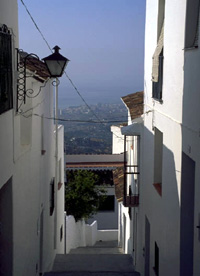 Like the French, Spaniards have developed the art of cooking with wine. Sherry is often used in various recipes for cooking veal, crab, and kidneys. Cooking with chocolate is a technique used since the days when Mexico was a colony. Game is highly prized, used in certain high-class dishes such as partridge, boar, and chamois. Spanish cheeses have a piquant taste and are made from goat’s milk (cabrales), ewe’s milk (manchego) and sometimes cow’s milk. The streets of Spanish towns are filled with the smell of churros. In cafes, tapas are served with glasses of wine. Orange trees grow in the heart of the city and watermelons are sold in public squares. Beer and cider are manufactured in addition to wine, and other specialties such as sangria, are very popular. Like the French, Spaniards have developed the art of cooking with wine. Sherry is often used in various recipes for cooking veal, crab, and kidneys. Cooking with chocolate is a technique used since the days when Mexico was a colony. Game is highly prized, used in certain high-class dishes such as partridge, boar, and chamois. Spanish cheeses have a piquant taste and are made from goat’s milk (cabrales), ewe’s milk (manchego) and sometimes cow’s milk. The streets of Spanish towns are filled with the smell of churros. In cafes, tapas are served with glasses of wine. Orange trees grow in the heart of the city and watermelons are sold in public squares. Beer and cider are manufactured in addition to wine, and other specialties such as sangria, are very popular.
Spanish Wine Spain is world famous as the homeland of sherry, one of the great fortified wines. But sherry is only one of the many wines of Spain. The country has the largest area under vines in Europe, although it is not the top producer. The first vines were probably planted by the Phoenicians in Andalusia around 1,100 BC and the Romans subsequently improved and consolidated the methods of cultivation and winemaking. Until fairly recently, Spanish table wines were not well known outside the peninsula, but in fact, some of the table wines, normally those of the northwest region, have been reputed for quality almost since medieval times and were, in addition, subject to controls. The rather full robust wines of several Spanish regions became popular as blending wines in various export markets. When these wines began to attract attention as wines in their own right, certain French terms were used to describe the characteristics of them. Modern technology has enabled the white wines to achieve a crisp, clean, and dry style and the reds to attain a full, agreeable, warm character. An enormous quantity of sparkling wines are made in the northeast, mainly in the Penedés region. Some of these are made according to the champagne process and others are produced in sealed vats. The gigantic installations of the sparkling wine makers, who export huge amounts of wine to America, are impressive even to the makers of champagne in France!
Mexican & Central American Mexican cookery, which has strongly influenced the cuisine of other Central American countries, combines old Indian traditions with the influence of the Spanish conquerors. The Spanish introduced the rearing of pigs, the cultivation of rice, and a new method of cooking, frying. The cuisine of the indigenous population relied on steaming and braising, which explains the great diversity of sauces and ragouts, which are also served with boiled or roast dishes. The main contribution of the Aztec civilization was the cultivation of corn, which together with red beans and rice constitutes the staple foods throughout the whole of Latin America. Other ingredients indigenous to the area include avocado, banana, pineapple, and papaw. 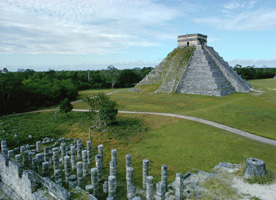 The most characteristic feature of Mexican and Central American cookery is the widespread use of chili peppers. About 100 varieties exist, ranging from bright red, to dark brown, most of which have a hot, pungent flavor (due to the seeds and "rib" of the peppers interior). Chili peppers are used almost indispensably in dishes of meats or vegetables. The most characteristic feature of Mexican and Central American cookery is the widespread use of chili peppers. About 100 varieties exist, ranging from bright red, to dark brown, most of which have a hot, pungent flavor (due to the seeds and "rib" of the peppers interior). Chili peppers are used almost indispensably in dishes of meats or vegetables. Meat in general is not very plentiful, apart from pork and chicken. Chicken is the main meat consumed in the region. The most popular drink is beer. Alcoholic beverages of various strengths are distilled from the yucca and the agave plant (tequila, mescal, etc.). The cookery of other Central American countries are very similar, and include tortillas, tamales, empanadas, omelettes, black beans, vegetable soups, and fish (particularly in Nicaragua).
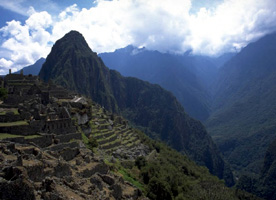 South American South American The highly spiced cuisine of the South American countries betrays its Spanish and Portuguese origins of stews, fish and seafood with an emphasis on fried food. In other ways, the African slaves introduced their own dietary habits, as did the European colonists: the Italians to Argentina, the Germans to Bolivia, and the French to Guyana and Venezuela, where the cuisine is more delicate. A large quantity of meat is eaten in livestock breeding regions, sometimes dried, but more often grilled in open air cooking. Local recipes remain colorful however; armadillo is still eaten, as well as iguana eggs, and large grilled ants. All South American countries use red beans, potatoes, rice, corn (it’s flour, leaves, and ears are used indispensably). Tropical fruits, which are extremely varied, are eaten with vegetables, as salads, juiced, or made into jellies. The desserts are primarily extremely sweet. Argentina ��" Argentineans eat a lot of meat, particularly beef, which they serve in large portions, either roasted or grilled. But this does not exclude more elaborate dishes, such as beef broth garnished with pumpkin and ears of corn. This great livestock breeding country also produces such cheeses as tafi, , which is like Cantal, and dulce de leche, a sweet spread made from aromatic infused condensed milk, eaten throughout South America. Bolivia - With Peru, Bolivia is the potatoes country of origin, and prides itself on producing more than 300 varieties. Apart from highly spiced soups and small fried dishes cooked in the open air, Bolivian cuisine has one specialty, Conejo Estirado, a dish made from rabbit, which has been stretched out to make the flesh very delicate. 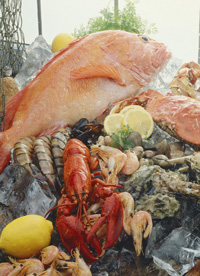 Brazil - Influenced by the Portuguese, Brazilian cuisine is, with that of Peru, the most varied and refined of South America. The Indians have contributed cassava flour, cocoa, sweet potatoes, and peanuts; Africans have imported yams, bananas, coconuts, and above all, palm oil, which gives its flavor to all fried dishes. Fish and seafood are widely consumed in the northeast. The cakes and pastries of this region are highly prized and include: flavored custards, cakes made with coconut or prunes, and given picturesque names such as: angels’ cheeks, young girls saliva, and mother-in-laws eye. The typical dishes of Central Brazil are grilled meats and everywhere cream cheese is eaten with guava jelly. The south has a copious and abundant cuisine with such dishes as offal in ragout and fruit stuff poultry. Brazil - Influenced by the Portuguese, Brazilian cuisine is, with that of Peru, the most varied and refined of South America. The Indians have contributed cassava flour, cocoa, sweet potatoes, and peanuts; Africans have imported yams, bananas, coconuts, and above all, palm oil, which gives its flavor to all fried dishes. Fish and seafood are widely consumed in the northeast. The cakes and pastries of this region are highly prized and include: flavored custards, cakes made with coconut or prunes, and given picturesque names such as: angels’ cheeks, young girls saliva, and mother-in-laws eye. The typical dishes of Central Brazil are grilled meats and everywhere cream cheese is eaten with guava jelly. The south has a copious and abundant cuisine with such dishes as offal in ragout and fruit stuff poultry. Chile - The quality of the meat is excellent, particularly the grilled mutton. The abundance of seafood is reflected in the cuisine, which is invariably seasoned with pimiento and onion. 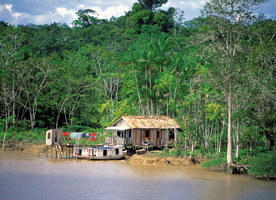 Columbia - Scrabbled eggs with tomato and onions are served from breakfast onwards, tamales and empanadas are nibbled all day. Stews are very substantial with corn biscuits used as bread. Coconut, which is very popular, maybe used as often with sauces as with desserts. Strawberries and oranges are as plentiful as papaw and passion fruit. Columbia - Scrabbled eggs with tomato and onions are served from breakfast onwards, tamales and empanadas are nibbled all day. Stews are very substantial with corn biscuits used as bread. Coconut, which is very popular, maybe used as often with sauces as with desserts. Strawberries and oranges are as plentiful as papaw and passion fruit. Ecuador - Varieties of bananas are are particularily numerous, and are used in almost all recipes. A large quantity of marinated raw fish is eaten, as well as soups, savory pies, and tamales. On All Saints Day, the major holiday of the year, hundreds of little decorated sugar cakes are made and families come to eat them on the graves of their loved ones. Guyana, French Guiana - Some authentic Indian dishes are still eaten in this region, based on such items as armadillo and alligator, but the day to day diet is based on Creole cooking. 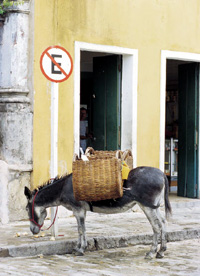 Paraguay and Uruguay ��" Here, the food is the same as in Argentina, with the addition of fresh water fish and abundant game. Hearts of palm are mainly produced in this region. Paraguay and Uruguay ��" Here, the food is the same as in Argentina, with the addition of fresh water fish and abundant game. Hearts of palm are mainly produced in this region. Peru - Peruvian cooking is as highly spiced as that of Mexico, has maintained the use of the pachamanca, an oven dug out of the earth in which a pig, goat, or chicken is cooked with corn, potatoes, and herbs. Peru is the country of ceviche, marinade of raw fish served with sweet limes, onions, tomatoes, and corn. Also, potatoes are used extensively. Venezuela - This country has the mildest cuisine in South America, again featuring beef, red beans mix with rice, and corn. The arepa, or corn bisquit, accompanies every dish. Papaw and bananas are used extensively. View some of our Hispanic recipes
 | Paella
Difficulty Level: Medium A Spanish traditional dish of seafood, meats, and rice |
| |
|
|



